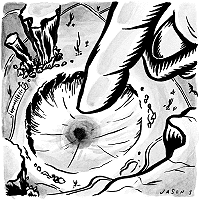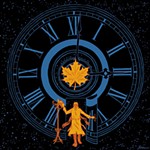Rainbows at Your Feet
Letters at 3AM
By Michael Ventura, Fri., Aug. 29, 1997
| |
Too fantastic for expression. No one, not even Georgia O'Keeffe, paints anything as daring as these forms. No one, not even Ansel Adams or John Ford, can photograph this vastness. For art must finally have a limit, a frame; but there are no limits here. No matter how great an artist's heart or technique, there comes a point at which the painting or photo has to end; but the power of this dreamscape is that it seems never to end. Its forms don't seem fixed. The very rocks are shape-changers under the motion of sun and moon. No matter how many commercials cheapen Monument Valley, no matter how many postcards glossy up Canyon de Chelley, no matter how many gaga tourists snap photos, something undermines all our attempts to bring this God-scape down to our level. For here it's not as though we're looking at the land, it's as though the land is looking at us. A sense of being stared at by Timelessness itself. And it is hard not to flinch under its glare.
Summer brings legions of vans and buses, thousands of dazed people, scooting from view to view, leaping from their vehicles, snapping pictures or making a quick sweep with video rigs, then hopping back into their cars. At one grand vista, where my friend and I stayed a long while, I timed the average tourist stop: four minutes. Not one stayed more than 10. It wasn't unusual for the driver to remain in the car with the motor running, while others leapt out, took photos, and left -- in less than two minutes. Mashing these magic vistas into a snapshot. They will spend more time looking at their flimsy artifacts than they did looking at the real thing. What is there to call this behavior but hysterical? What does it mean, to need activity so desperately that you can no longer be arrested by the sight of something larger and more mysterious than your life? These are people terrified of beauty. As though truly to take in beauty would throw their entire lives into question. (And it would.)
It is easy to feel superior to such behavior, but I soon realized that my superiority was a shield against deeper feelings of pity and panic. Pity that so many of one's own kind have developed such callousness to beauty. Panic that they are one's own kind -- part of the civilization by which I, too, came here, the civilization that is my vehicle and my sustenance. "Any man's death diminishes me." What is more deadly than a deadened sense of beauty? To feel superior to is to lie to myself. We came by the same roads, under the same flag. We have been entrusted with the same inheritance; and we seem, in our different ways, powerless to uphold that inheritance. We are equal sharers in the same disaster.
Here's a measure of that disaster. North of Monument Valley, at a place called Mexican Hat: A Navajo admires my '69 Chevy. He has a weary, intelligent face. We talk cars. The brakes on his are weak. He asks if I like it here. I say something to the effect that the landscape overwhelms me. He gives a little shrug, a hopeless look, says: "Once you get used to it, you don't really like it."
He is speaking of his birthright, which my civilization has diminished in his own eyes. Our capacity to drain the perception of beauty has infected him, and how many others like him? I'm not speaking of the sins of the past against his people (for which our guilt does little or no good), but of the sin of the present, the sin against beauty: The refusal to stand still with reverence. Meanwhile the dreamlike rock formations look down at us, throbbing with a magic that has less and less to do with us.
But disasters are relative in the painted Desert. Go to Meteor Crater, west of Winslow. Fifty thousand years ago, a mass weighing several hundred thousand tons, a piece of space stone billions of years old, smashed into this ground at 40,000 miles an hour. It is said there were no human beings on the continent then. But every deer and cougar and mammoth and bear and coyote and bird could see that burning stone roaring down. It made a crater 60 stories deep, 4,000 feet across, and three miles round. The impact killed every living thing for 100 miles in every direction -- devastation far greater than we managed at Hiroshima.
Here, my friend and I lined up on the observation decks with the others. Our two silences linked up -- each silence strengthening the other against the chatter around us. Yet the chatter here was different, laced with wonder. Most of these people didn't know enough geology to have the barest understanding of the Painted Desert, didn't know an ancient volcano when they saw it or a lava flow when they camped upon it. But each had an animal understanding of a burning rock hurtling out of the sky. And all shared an awe both selfish and religious. Selfish, for many were saying how it could happen again, smack on their heads; religious because that is the only word to use when one faces, however superficially, the sense of an uncontrollable force reaching us directly from the deeps of space.
There were benches at a shaded area on the crater's edge. We sat on one. At the next were an older, solemn African-American couple. An Anglo woman in her thirties sat by them. She was trying to keep track of her three boys, all adolescents, who insisted on hovering precariously at the edge of the drop. I liked this woman's face. It was, in a word, alive. Attentive. Guileless. Unlike almost everybody else, she was completely present, and so excited by the place that she had to talk. The couple on the bench listened politely. She spoke of her kids, and of how awed she was by the crater. In her excitement, she told her story: She was a girl on a roller coaster, it leapt the tracks, she'd broken her neck, should have died; but she'd mended, she'd borne children, and here she was at this awesome place.
It's easy to see why the crater drew her story from her. She was no stranger to sudden plummetings. She, like the meteor, had once hurtled to earth by a quirk of fate. And what had this given her? In her words: "I don't believe anything but the word of God, that's it." She said this with passionate yet cheerful excitement. She seemed, to me, not a fanatic but a believer. (There is a difference.) This Apocalyptic dreamscape, and this crater, thrilled her and made a kind of sense to her, because it was further evidence of the unknowable and wild will of God.
It doesn't take belief in God to sense that something unknowable and wild is at play in our lives; nor to see that, everywhere we look, nature works in intricate patterns interrupted by drastic changes; nor to wonder whether these patterns and changes exhibit something like will. I, too, call it God, and feel it as the presence of God; but that may be a technicality. It could be the wind, for all I know. But wind, too, sometimes seems to have a will.
Then this woman said something to that patient couple that I had never heard before. She said: "God created the world old."
I will be a long time refreshed by the implications of her idea. God created the world old. Maybe those words, for her, were merely a Creationist dodge, a way for scripture to make its stand against science -- I have no way to know that. But her sentence has a life of its own, and it makes the rocks speak. It helps restore reverence. For what is reverence but a kind of remembrance? To remember, for instance, that every element in these rocks, and every element in our bodies, was cooked in novas that exploded beyond our sense of time. We and the rocks were created out of very old building blocks. Created old. If we sit still enough, long enough, we feel that ancientness within us. (Is this what gives some of us the sense of having a soul?) Perhaps it's why some feel a camaraderie with these strangely shaped stones and volcanic cones -- and why others are afraid to feel, afraid that what is ancient in us will judge us, with or without the wild will of God. For that ancientness is our inheritance, far more than the transitory inheritance of what we call "America." And the weight of an inheritance is that it must be met, lived up to, extended -- or run from. This Painted Desert, where rainbows are at your feet as well as in the sky, evokes a source we can neither ultimately reject nor harm, however hard we try. We can corrupt the forms, but not the ancient elements that compose them. We can destroy our world, but not that whereby our world was created.
And that woman -- she took no pictures, except with her eyes and with her faith. The technicalities of that faith may not be mine or yours, but she was no stranger to these stones. Nor are we. Not really. We are made of the same stuff, and, like them, created old. And what is faith, at its source, but a sense of our ancient and unbreakable connection to all that is?









